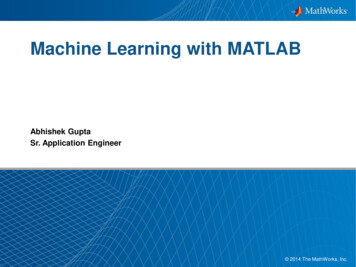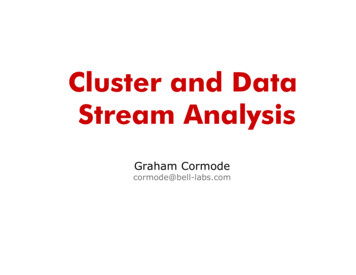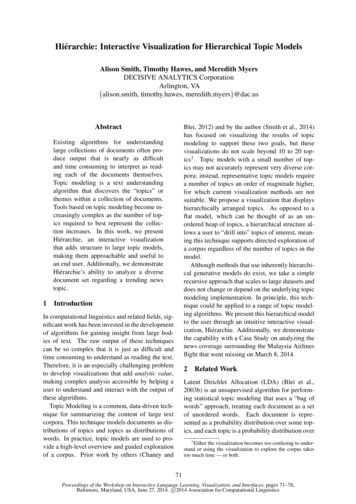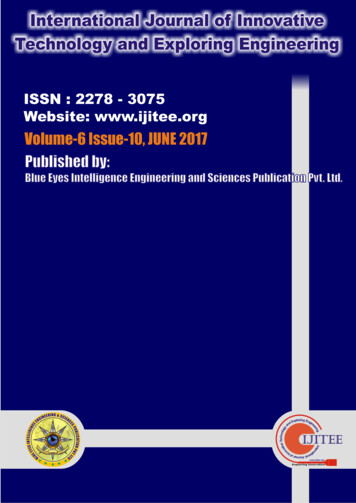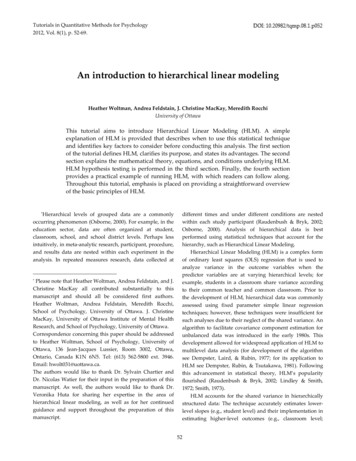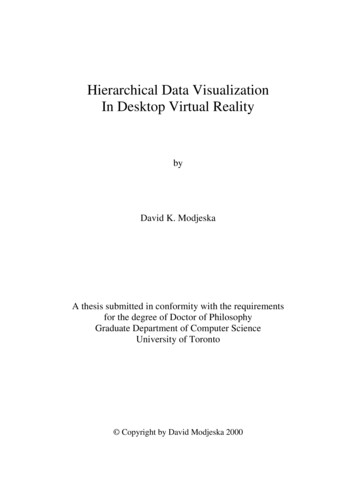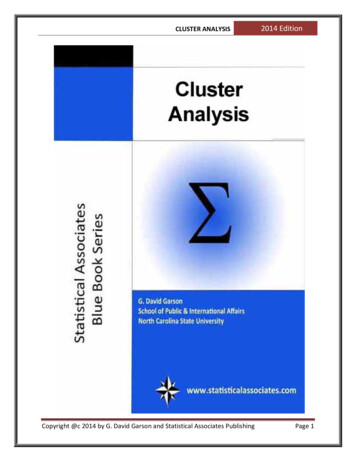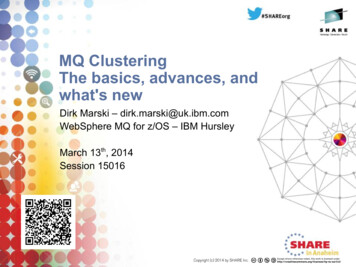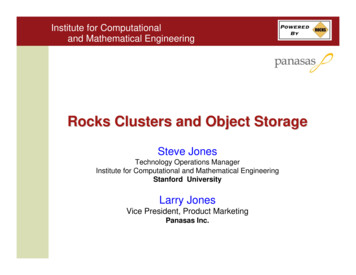
Transcription
HIERARCHICAL CLUSTERING WITH GLOBAL OBJECTIVES:APPROXIMATION ALGORITHMS AND HARDNESS RESULTSA DISSERTATIONSUBMITTED TO THE DEPARTMENT OF COMPUTER SCIENCEAND THE COMMITTEE ON GRADUATE STUDIESOF STANFORD UNIVERSITYIN PARTIAL FULFILLMENT OF THE REQUIREMENTSFOR THE DEGREE OFDOCTOR OF PHILOSOPHYEvangelos ChatziafratisJune 2020
2020 by Evangelos Chatziafratis. All Rights Reserved.Re-distributed by Stanford University under license with the author.This work is licensed under a Creative Commons AttributionNoncommercial 3.0 United States 3.0/us/This dissertation is online at: http://purl.stanford.edu/bb164pj1759ii
I certify that I have read this dissertation and that, in my opinion, it is fully adequatein scope and quality as a dissertation for the degree of Doctor of Philosophy.Tim Roughgarden, Primary AdviserI certify that I have read this dissertation and that, in my opinion, it is fully adequatein scope and quality as a dissertation for the degree of Doctor of Philosophy.Moses Charikar, Co-AdviserI certify that I have read this dissertation and that, in my opinion, it is fully adequatein scope and quality as a dissertation for the degree of Doctor of Philosophy.Li-Yang TanI certify that I have read this dissertation and that, in my opinion, it is fully adequatein scope and quality as a dissertation for the degree of Doctor of Philosophy.Gregory ValiantApproved for the Stanford University Committee on Graduate Studies.Stacey F. Bent, Vice Provost for Graduate EducationThis signature page was generated electronically upon submission of this dissertation inelectronic format. An original signed hard copy of the signature page is on file inUniversity Archives.iii
AbstractHierarchical Clustering is an important tool for data analysis, used in diverse areas ranging fromPhylogenetics in Biology to YouTube video recommendations and everything in between. The term“hierarchical” is used to contrast with “flat” clustering approaches, like k-means or k-center, whichonly produce one specific partitioning of a data set. Hierarchical Clustering is a way of understandingthe overall structure of large data sets by visualizing them as a collection of successively smallerand smaller clusters, capturing di erent levels of granularity simultaneously. The end result is atree, whose internal nodes represent nested clusters and with leaves representing the data points.Despite the plethora of applications and heuristics, the theory behind Hierarchical Clustering wasunderdeveloped, since no “global” objective function was associated with the final output. A wellformulated objective allows us to compare di erent algorithms, measure their quality, explain theirsuccess or failure and enables continuous optimization methods with gradient descent. This lack ofobjectives is in stark contrast with the flat clustering literature, where objectives like k-means, kmedian or k-center have been studied intensively starting from the 1950s, leading to a comprehensivetheory on clustering.In this thesis, we study approximation algorithms and their limitations, making progress towardsbuilding such a theory for objective-based Hierarchical Clustering (HC). For the minimization costfunction with pairwise similarities introduced recently by Dasgupta (2016) and its maximizationvariants, we show how standard tools like Sparsest Cut, Balanced Cut, Max Cut or Max UncutBisection can be used in a black box manner, to produce provably good HC and we also complementour algorithms with inapproximability results. Escaping from worst-case analyses, we also studyscenarios where extra structure is imposed on the data points (e.g., feature vectors) or qualitativeinformation is provided (e.g., the common triplet or quartet constraints in Phylogenetics). Ourresults are inspired by geometric ideas (semidefinite programming relaxations, spreading metrics,random projections) and novel connections with ordering Constraint Satisfaction Problems.Overall, this thesis provides state-of-the-art approximation and hardness results for optimizingglobal HC objectives, reveals unexpected connections with common linkage or graph cut heuristicsand advances our understanding of old Phylogenetics problems. As such, we hope it serves the community as the foundation for objective-based Hierarchical Clustering and for future improvements.iv
AcknowledgmentsAs I am finishing my thesis from an apartment in New York, I can’t help but thinking how luckyI have been so far, especially throughout those 5 years of my PhD. Featuring a single name onthe front cover is merely an understatement, as both this thesis and myself would not be the samewithout the tremendous help and constant support of several amazing individuals, I had the extremepleasure to meet along my journey in research and in the academic world. Given that no physicalPhD defense ever took place at Stanford, I want to take this opportunity to express my gratitudeto the people that helped me during this beautiful journey and, more importantly, made it possible.First and foremost, I can’t thank enough my advisor Tim Roughgarden for all he has done forme over these past 5 years. From my second quarter at Stanford, when I first rotated and workedwith Tim, to our productive research trip in London School of Economics during his sabbatical, toour path towards New York in Columbia and my next career steps, Tim has always been extremelysupportive and patient of my diverse research pursuits, always ready to provide me with his insightfulideas and advice. I owe him so much for his mentorship and ideas, for inspiring me, for teachingme cool stu and helping me improve my communication skills; and all these, done in the casualenvironment he created for his group (lunches at Ike’s, dinners at NOLA etc.), which allowed meto thrive without ever feeling I was working, rather enjoying research and theory. Outside research,I also want to thank Tim, simply for being lenient with me, accepting my longer-than-usual tripsto Greece, without asking questions whether they happened during (early) summer, Christmas, oreven March. I also consider myself privileged to have been his unique student simultaneously atStanford and Columbia, and to have helped with the summer rental car situation in Ikaria and withthe cameras and amplifiers during Papafest’s talks and band concert.The second person that I want to thank is Moses Charikar. During the spring quarter of my firstyear, we started exploring hierarchical clustering, a term I had never heard about back then and,unknowingly, the main chapter in this thesis had already started. Collaborating with Moses andtrying to make sense of the variety of clustering questions that appeared on our way over time, hastruly been an immense pleasure. His intuition and clarity of thought together with his patience onexplaining to me possible ways of attacking the problems have been extremely beneficial. I am alsograteful to him for being available for late night Skypes in several occasions and for interrupting hisv
dinner plans just to answer my texts, admittedly right before the submission deadlines, and finallyfor battling with the di erent timezones when I was in Switzerland or in Sweden and he was inIndia.I also want to thank Jan Vondrak, not only for our collaboration, but also for being a friendly andapproachable person in the Math department, that I always felt comfortable talking to and I couldalways go with questions and have interesting conversations across many di erent topics. Of course,I am glad he also agreed to be the Chair of my thesis committee. I want to thank Greg Valiant forbeing in my orals committee, for letting me TA several of his courses and for his support duringsummer 2017. Also, for his direct and casual character that always makes you feel comfortable. Ialso owe a big thanks to Li-Yang Tan for agreeing to be in my quals and my orals committee andfor sharing much of his love and expertise in complexity theory.I also want to thank several professors I had the pleasure to work with for a short period: VirginiaVassilevska Williams for an awesome first rotation, and for her great teaching style, Nisheeth Vishnoifor an inspiring summer internship in EPFL during summer 2016, which taught me a lot and OsmanYagan for several visits to CMU in Silicon Valley and in Pittsburgh and for interesting discussionson network robustness. Outside research, I want to thank Omer Reingold for an amazing class onPlayback theater and Kumaran Arul for being an excellent and inspiring piano tutor. WatchingRyan Williams playing guitar, singing and improvising during our Theory Music Tuesday Nightshas also been quite the experience!A big role for the development of this thesis was played by my amazing collaborators. First ofall, I want to thank Rad Niazadeh for the countless hours we spent drawing trees and clusters on thewhiteboard, discussing about how to round SDPs, late-night editing of papers before submissions,and also for giving me career advice. I want to thank Mohammad Mahdian for being an amazinghost at Google New York during my summer and winter internships, for the always stimulatingconversations that may happen at a microkitchen or while searching for available rooms, over videocalls, or even while on vacation in Rhodes, Greece. I want to thank Ioannis Panageas for hostingme in Singapore, for his direct and fun character and for his mathematical depth that helpedme explore and appreciate the many interesting connections between deep learning and dynamicalsystems. Moreover and in no particular order, I also had the pleasure to work with: Neha Gupta,Euiwoong Lee, Sara Ahmadian, Alessandro Epasto, Grigory Yaroslavtsev, Kontantin Makarychev,Sai Ganesh Nagarajan, Xiao Wang, Haris Angelidakis, Avrim Blum, Chen Dan, Pranjal Awasthi,Xue Chen, Aravindan Vijayaraghavan, Osman Yagan, and Joshua Wang. I also want to thank OkkeSchrijvers and his team at Facebook for hosting me over the summer of 2018: Julián Mestre, NicolasStier-Moses and Birce Tezel.My time at Stanford and New York would not be as fun and carefree as it has been, withoutthe necessary balance that came from my friends. First, I would like to thank Mary Ann and BobPoulos and their amazing family Olivia, Lindsey and Lauren that took care of me, for their supportvi
and their hospitality. I want to thank my friends in Hellas (Stanford’s Greek community) for all thenice events we organized over Easter, Christmas and summer and for all the help and advice theyprovided during these years: our statistician Nikos Ignatiadis, our tamias (treasurer) Kostis Ka esand vice-president Faidra Monachou, our doctor Stelios Serghiou and biologist Eirini Tsekitsidou,to (the) Peter Zachares, our petroleum experts Dimitris Belivanis and Philippos Kostakis, ourbasketball player George Korakitis, our minaras Marios Galanis from Patras, my mentor YorgosKatsikis and our life-coach Vasilis Verroios. See you in Cholargos, at President’s souvlaki or Shisansushi ;) Also, the other Greeks from my incoming year George Alexopoulos, George Chrysochoos,Georgios Laskaris, Iakovos Anagnostopoulos that helped me adapt to the new environment andAlexios Voulimeneas for the Halloween Sparta costumes. I would also like to thank my friends in NewYork: Ilias Zadik, Orestis Plevrakis, Themis Melissaris, Lampros Flokas, Manolis Vlatakis, GiannisKaramanolakis, Thodoris Lykouris, and Fotis Iliopoulos for hosting me when in need, for givingme valuable presentation feedback and laughs at online Codenames, and for interesting researchdiscussions.My time in the theory groups at Stanford and Columbia would not be as fun and memorable,if it weren’t for the many board games, theory retreats, research talks, food and concerns sharedwith my fellow grad students: in no particular order thank you to Amir Abboud, Kostas Kollias,Leo Keselman, Josh Alman, Brian Axelrod, Greg Bodwin, Saba Eskadarian, Shivam Garg, ParisSyminelakis, Nicole Wein, Hilal Asi, Sam Kim, Ofir Geri, Neha Gupta, Reyna Hulett, Ray Li,Noah Shutty, Michael Kim, Andrea Lincoln, Annie Mardsen, Tony Kim, Jimmy Wu, Bruce Spang,Kevin Tian, Warut Suksompong, Vasilis Gkatzelis, Weihao Kong, Okke Schrijvers, Dylan McKay,Aditi Raghunathan, Henry Corrigan-Gibbs, Dima Kogan, Yeganeh Alimohammadi, Benedikt Bünz,Florian Tramer, Josh Wang, Vatsal Sharan, Kiran Shiragur, Shashwat Silas, Hongyang Zhang, andClayton Sanford. I owe huge thanks to Megan Harris, Ruth Harris, Jay Subramanian and JamKiattinant for helping me in anything I needed and always being there for the students. Also, I owethanks to Katerina Magkel and the Onassis Foundation for supporting in part my studies duringthe 2019-2020 academic year.Finally, I want to thank my professors Stathis Zachos, Dimitris Fotakis and Aris Pagourtzis fortheir excellent work, for inspiring so many students during my undergraduate studies in NTUAand for making us love and eventually follow the path towards Algorithms and Theory. Also,thanks to all my friends in EPFL and ETH, Prodromos Kolyvakis, Georgios Damaskinos, LefterisKokoris-kogias and Harris Angelidakis for making my stay in Switzerland so easy and smooth, myfriends in Athens, George Banis, Nikos Mavroulis, Alexandros Banis, Manos Sofoulis, Marios Fouzas,Dennis Triantafillis II, Steve Mitropoulos, Nasos Georgiou, Alexia Athanasiou, Alexis Markazos, andAlexandros Georgopoulos for their endless supply of interesting conversations, funny stories, memes,discussions and memorable vacations.I want to thank my girlfriend Yuuki Miura for being an amazing companion, her hospitalityvii
during Big ’Rona and her inspiring kindness and good character. Last but not least, I can’t thankenough my family for everything they have done for me and continue to do, for everything they havetaught me and continue to teach me and for their endless love and support for whatever I did andcontinue to do.viii
Dedicated to my first teachers, my familyChryssa, Anna-Maria, Telemachos, Andreas, Stratosix
To pr to skal–The First StepEic ton JeÏkrito paraponio‘ntanThe young poet Evmenismià mËra o nËoc poiht†c EumËnhc·complained one day to Theocritus: T ra duÏ qrÏnia pËrasan pou gràfw“I’ve been writing for two years nowk’ Ëna eid‘lio Ëkama monàqa.and I’ve composed only one idyll.To mÏnon àrtiÏn mou Ërgon e–nai.It’s my single completed work.Allo–monon, e–n’ uyhl† to blËpw,I see, sadly, that the ladderpol‘ uyhl† thc Poi†sewc h skàla·of Poetry is tall, extremely tall;kai ap’ to skal– to pr to ed pou e–maiand from this first step I’m standing on nowpotË den j’ anaib o dustuqismËnoc .I’ll never climb any higher.”Eip’ o JeÏkritoc·Theocritus retorted: “Words like that Autà ta lÏgiaanàrmosta kai blasfhm–ec e–nai.are improper, blasphemous.Ki an e–sai sto skal– to pr to, prËpeiJust to be on the first stepnàsai uper†fanoc k’ eutuqismËnoc.should make you happy and proud.Ed pou Ëfjasec, l–go den e–nai·To have reached this point is no small deed:tÏso pou Ëkamec, megàlh dÏxa.what you’ve done already is wonderful.Ki autÏ akÏmh to skal– to pr toEven this first steppol‘ apÏ ton koinÏ ton kÏsmo apËqei.is a long way above the ordinary world.Eic to skal– gia na pat†seic to‘toTo stand on this stepprËpei me to dika–wmà sou nàsaiyou must be in your own rightpol–thc eic twn ide n thn pÏli.a member of the city of ideas.Kai d‘skolo sthn pÏli eke–nhn e–naiAnd it’s a hard, unusual thingkai spànio na se politograf†soun.to be enrolled as a citizen of that city.Sthn agorà thc br–skeic NomojËtacIts councils are full of Legislatorspou den gelà kanËnac tuqodi kthc.no charlatan can fool.Ed pou Ëfjasec, l–go den e–nai·To have reached this point is no small deed:tÏso pou Ëkamec, megàlh dÏxa .what you’ve done already is wonderful.”Kwnstant–noc P. KabàfhcConstantine P. Cavafyx
This thesis is based on previously published and ongoing works:1. Chapter 4 is based on the following three papers: “Approximate Hierarchical Clustering via Sparsest Cut and Spreading Metrics”from SODA 2017 [27] “Hierarchical Clustering better than Average-Linkage” from SODA 2019 [28] “Bisect and Conquer: Hierarchical Clustering via Max-Uncut Bisection”from AISTATS 2020 [2].2. Chapter 5 is based on “Hierarchical Clustering for Euclidean Data” from AISTATS 2019 [29].3. Chapter 6 is based on the following two papers: “Hierarchical Clustering with Structural Constraints” from ICML 2018 [35] “Aggregating Inconsistent Information in Ranking, Clustering and Phylogenetic Trees”,manuscript under submission, May 2020 [34].xi
ContentsAbstractivAcknowledgmentsv1 Introduction11.1Basic Concepts in Hierarchical Clustering (HC) . . . . . . . . . . . . . . . . . . . . .41.1.1Trees, Subtrees and Ancestors . . . . . . . . . . . . . . . . . . . . . . . . . . .41.1.2– How many trees are there? – Simply, too many! . . . . . . . . . . . . . . .61.2Global Objectives for Hierarchical Clustering . . . . . . . . . . . . . . . . . . . . . .81.3Heuristics for Hierarchical Clustering . . . . . . . . . . . . . . . . . . . . . . . . . . .101.4Constrained Hierarchical Clustering . . . . . . . . . . . . . . . . . . . . . . . . . . .131.4.1Connections to Consistency in Phylogenetics . . . . . . . . . . . . . . . . . .131.4.2Connections to Correlation Clustering and Rankings . . . . . . . . . . . . . .151.5Further Related Work . . . . . . . . . . . . . . . . . . . . . . . . . . . . . . . . . . .161.6Structure of this PhD Thesis . . . . . . . . . . . . . . . . . . . . . . . . . . . . . . .172 Gentle Overview of Main Results2.118Black-box Approximations for Hierarchical Clustering . . . . . . . . . . . . . . . . .182.1.1Minimizing Dasgupta’s cost via Graph Cuts and Spreading Metrics . . . . . .192.1.2Maximization HC: Variations on a Theme . . . . . . . . . . . . . . . . . . . .202.1.3Two Hardness Results from Small-Set Expansion . . . . . . . . . . . . . .212.2Hierarchical Clustering for Euclidean Data . . . . . . . . . . . . . . . . . . . . . . . .222.3Hierarchical Clustering with Structural Constraints . . . . . . . . . . . . . . . . . . .232.3.1Connections to Rankings, Correlation Clustering and Phylogeny Reconstruction 233 Preliminaries253.1Background in Algorithms and Hardness . . . . . . . . . . . . . . . . . . . . . . . . .253.2Global Objectives for Hierarchical Clustering . . . . . . . . . . . . . . . . . . . . . .27xii
4 Black-box Approximations for Hierarchical Clustering4.14.230Minimizing HC cost: Graph Cuts and Spreading Metrics . . . . . . . . . . . . . . . .304.1.1Recursive Sparsest Cut . . . . . . . . . . . . . . . . . . . . . . . . . . . . . .314.1.2Using Balanced Cut instead of Sparsest Cut . . . . . . . . . . . . . . . . . . .344.1.3Generalized HC Cost Function Approximation . . . . . . . . . . . . . . . . .364.1.4384.1.5Convex Relaxations for HC . . . . . . . . . . . . . . . . . . . . . . . . . . . .pO( log n) approximation for Hierarchical Clustering . . . . . . . . . . . . . .414.1.6An LP-based O(log n) approximation via spreading metrics . . . . . . . . . .424.1.7Hardness via Min Linear Arrangement and Small Set Expansion . . . . . . .46Maximization HC: Variations on a Theme . . . . . . . . . . . . . . . . . . . . . . . .47similarity-HC is a tight 13 -approximation . .dissimilarity-HC is a tight 23 -approximation4.2.1Average-Linkage for. . . . . . .494.2.2Average-Linkage for. . . . . . .514.2.3Beating Average Linkage via SDP for the Moseley-Wang HC Objective . . .524.2.4Beating Average Linkage via MaxCut for Dissimilarity HC . . . . . . . . . .584.2.5An improved 0.42-approximation for Moseley-Wang . . . . . . . . . . . . . .644.2.6Hardness for Moseley-Wang via Small Set Expansion . . . . . . . . . . . . . .725 Hierarchical Clustering for Euclidean Data755.1Setting: Feature Vectors with Gaussian Kernel . . . . . . . . . . . . . . . . . . . . .765.2Performance of Average Linkage . . . . . . . . . . . . . . . . . . . . . . . . . . . . .785.3Greedy Cutting and Single-linkage. . . . . . . . . . . . . . . . . . . . . . . . . . . . .815.4A Fast Algorithm based on Random Projections . . . . . . . . . . . . . . . . . . . .835.4.1. . . . . . . . . . . . . . . . . . . . . . . . . .86Hard Instances with Gaussian Kernel . . . . . . . . . . . . . . . . . . . . . . . . . . .875.5.1915.5Gaussian Kernels with smallDatasets from Section 5.5 . . . . . . . . . . . . . . . . . . . . . . . . . . . . .6 Hierarchical Clustering with Structural Constraints926.1Motivation and Chapter Overview . . . . . . . . . . . . . . . . . . . . . . . . . . . .936.2Minimizing Dasgupta’s Objective with Triplets . . . . . . . . . . . . . . . . . . . . .966.2.1Modified Sparsest or Balanced Cut Analysis . . . . . . . . . . . . . . . .966.2.2Soft Triplets and Regularization . . . . . . . . . . . . . . . . . . . . . . . . . 1006.2.3Dissimilarity HC and Constraint Dependencies . . . . . . . . . . . . . . . . . 1026.3Old Biology Problems: Triplets/Quartets Consistency . . . . . . . . . . . . . . . . . 1086.3.1Hardness for Rooted Triplets Consistency . . . . . . . . . . . . . . . . . . . . 1086.3.2Hardness for Forbidden Triplets: Random is Optimal . . . . . . . . . . . . . . 110xiii
7 Conclusion & Open Questions1127.1Conclusion. . . . . . . . . . . . . . . . . . . . . . . . . . . . . . . . . . . . . . . . . 1127.2List of Open Problems and Conjectures . . . . . . . . . . . . . . . . . . . . . . . . . 112A Omitted Proofs, Discussions and Experiments115A.1 Omitted Proofs from Chapters. . . . . . . . . . . . . . . . . . . . . . . . . . . . . . . 115A.1.1 Missing proofs and discussion in Section 6.2.1 . . . . . . . . . . . . . . . . . . 115A.1.2 Missing proofs in Section 6.2.2 . . . . . . . . . . . . . . . . . . . . . . . . . . 118A.1.3 Missing proofs in Section 6.2.3 . . . . . . . . . . . . . . . . . . . . . . . . . . 118A.2 Experiments and Discussion from Chapter 6 . . . . . . . . . . . . . . . . . . . . . . . 121A.2.1 Experimental Results . . . . . . . . . . . . . . . . . . . . . . . . . . . . . . . 122A.3 Deferred Proofs of Section 4.2.1 . . . . . . . . . . . . . . . . . . . . . . . . . . . . . . 123A.4 Deferred Proofs of Section 4.2.3 . . . . . . . . . . . . . . . . . . . . . . . . . . . . . . 124A.5 Deferred Proofs of Section 4.2.4 . . . . . . . . . . . . . . . . . . . . . . . . . . . . . . 125xiv
List of Tables4.1A guide through the di erent variable names used in the proof. . . . . . . . . . . . .5.1Values of the objective (times 10) on the Zoo dataset (averaged over 10 runs). . .905.2Running times of PRC and one pass. . . . . . . . . . . . . . . . . . . . . . . . . . .91361A.1 Results obtained for the Zoo dataset. . . . . . . . . . . . . . . . . . . . . . . . . . . . 122xv
List of Figures1.1Tree of Life in Biology . . . . . . . . . . . . . . . . . . . . . . . . . . . . . . . . . . .21.2Unrooted tree examples. . . . . . . . . . . . . . . . . . . . . . . . . . . . . . . . . . .51.3Example of a Dendrogram. . . . . . . . . . . . . . . . . . . . . . . . . . . . . . . . .51.4Caterpillar tree examples. . . . . . . . . . . . . . . . . . . . . . . . . . . . . . . . . .61.5Possible combinations for generating binary rooted trees. . . . . . . . . . . . . . . . .71.6Induced subtrees and least common ancestors. . . . . . . . . . . . . . . . . . . . . . .91.7Calculating the HC cost function of Dasgupta. . . . . . . . . . . . . . . . . . . . . .101.8Resolved quartets on three elements. . . . . . . . . . . . . . . . . . . . . . . . . . . .131.9Resolved triplets on three elements. . . . . . . . . . . . . . . . . . . . . . . . . . . . .144.1A top-down heuristic for finding HC. . . . . . . . . . . . . . . . . . . . . . . . . . . .314.2Level t decomposition in HC cost. . . . . . . . . . . . . . . . . . . . . . . . . . . .324.3Illustration of HC levels for Balanced Cut. . . . . . . . . . . . . . . . . . . . . . . . .354.4Tight Instance for Average-Linkage for Moseley-Wang Objective . . . . . . . . . . .504.5Tight Instance for Average-Linkage for Cohen-Addad et al. Objective . . . . . . . .514.6 The layered structure of the optimum tree T in Case 2. . . . . . . . . . . . . . . . . 604.7Splitting Tto size restricted sets A, B, C. . . . . . . . . . . . . . . . . . . . . . . . .665.1Illustration of the merging process in 1D. . . . . . . . . . . . . . . . . . . . . . . . .805.2Projecting the triangle (v1 , v2 , v3 ) on g. . . . . . . . . . . . . . . . . . . . . . . . . .845.3Clique Counterexample for Average-Linkage. . . . . . . . . . . . . . . . . . . . . . .886.1Rooted Triplet Constraints in Hierarchical Clustering . . . . . . . . . . . . . . . . . .936.2Decompoistion in Constrained Sparsest Cut analysis. . . . . . . . . . . . . . . . . . .986.3Transforming a 3-hyperedge to a triangle. . . . . . . . . . . . . . . . . . . . . . . . . 1026.4Counterexample for Recursive Densest Cut. . . . . . . . . . . . . . . . . . . . . . . . 1056.5Description of a class C with base {x, y}.6.66.7. . . . . . . . . . . . . . . . . . . . . . . . 105Classes {Ci , Cj }, and two situations for having Ci ! Cj . . . . . . . . . . . . . . . . . . 106Layered dependency subgraph of class C. . . . . . . . . . . . . . . . . . . . . . . . . . 107xvi
Chapter 1IntroductionI have this nightmare: that scientifichistorians of the future will say that duringthe 20th century, there were these sixty veryintellectually exciting years during whichoptimization was not just gradient descent.-Christos Papadimitriou (2019)This thesis is all about Hierarchical Clustering which, in some sense, is just a fancier way ofreferring to what computer scientists are taught to call simply, a “tree”. Thinking about trees hasbeen a mathematician’s recreation for many centuries. In 1857, the great British mathematicianArthur Cayley published an article “On the theory of the analytical forms called trees” and laterin 1889 another one “A theorem on trees”, where he gave formulas for counting di erent types oftrees [25, 26]. Such arguments are considered standard by now and typically, in undergraduatealgorithms, a student learns about binary trees and some of their amazing powers for speeding upbasic algorithmic problems. Here, we view trees as a way of understanding data sets and specificallyrelationships among data points.Hierarchical Clustering has become by now an essential tool for data analysis useful across diverseareas, ranging from Phylogenetics in Biology to YouTube video recommendations and everything inbetween. It originated in Biology, where researchers wanted to understand the evolution of species,their genetic similarities, possible speciation events throughout history and build a taxonomy onextinct and extant organisms, usually called the Tree of Life (see Figure 1.1). A major problemthen quickly appeared on how to aggregate vast amounts of information and automatically extractgroups of organisms that are similar together (e.g., types of di erent bacteria, birds or mammalsetc.).In computer science, the problem of partitioning a given data set into multiple groups is calledclustering and is well-studied; chances are, that any conference on theory or applications in computer1
CHAPTER 1. INTRODUCTION2Figure 1.1: In biology, understanding the origins and relations of species relies on using HierarchicalClustering.science features several papers on clustering. However, in the above example from Taxonomy, it iseasy to see that since an organism can belong simultaneously to multiple clusters at di erent levels ofgranularity (e.g., a cat belongs to the family of “Felidae” which is subclass of the class “Mammals”),standard “flat” clustering is no longer the right tool, as what we want is a hierarchy of clusters tocapture the naturally hierarchical structure of the evolution of species.As a result, we use the term “hierarchical” (etymology comes from the greek word hierarkhiameaning “sacred rules”) to contrast with “flat” clustering approaches, which only produce onespecific partitioning of a data set. Hierarchical Clustering is a way of understanding the overallstructure of large data sets by conveniently visualizing them as a collection of successively smallerand smaller clusters, capturing di erent levels of granularity simultaneously. The end result is a tree,whose internal nodes represent nested clusters and where data points lie at its lowest levels, withdissimilar data points being split towards the top of the tree and with similar data points being split
CHAPTER 1. INTRODUCTION3towards the bottom of the tree. To construct this tree, there are intuitive and easy to implementbottom-up merging methods or top-down divisive procedures.Once you are aware of it, you quickly realize that Hierarchical Clustering is everywhere asdata sets are of hierarchical nature. When analyzing social networks, solving community detection,organizing and recommending movies, retrieving relevant tweets and doing text analysis, suggestingads in online platforms, investigating gene relations to cancer, or investing money on large portfolios,at some point hierarchies on data will be required and Hierarchical Clustering sneaks in.But it’s not all good news, as there was something unsatisfactory about Hierarchical Clustering.Despite the plethora of applications and heuristics, the theory behind it was underdeveloped, partlybecause no “global” objective function, measuring the quality of the final output tree, was studied.A well-formulated objective allows us to compare di erent algorithms, measure their quality, explaintheir success or failure and enables continuous optimization methods with gradient descent. Thislack of objectives is in stark contrast with the flat clustering literature, where objectives like k-means,k-median or k-center have been studied intensively leading to a comprehensive theory on clustering.However, as is a common curse in computer science, most problems are hard to optimize, andhierarchical clustering is no exception. Thus, we need to turn our attention to approximatio
random projections) and novel connections with ordering Constraint Satisfaction Problems. Overall, this thesis provides state-of-the-art approximation and hardness results for optimizing global HC objectives, reveals unexpected connections with common linkage or graph cut heuristics and advances our understanding of old Phylogenetics problems.
